High Energy Properties of X-ray Sources observed with BeppoSAX
- 格式:pdf
- 大小:345.73 KB
- 文档页数:8
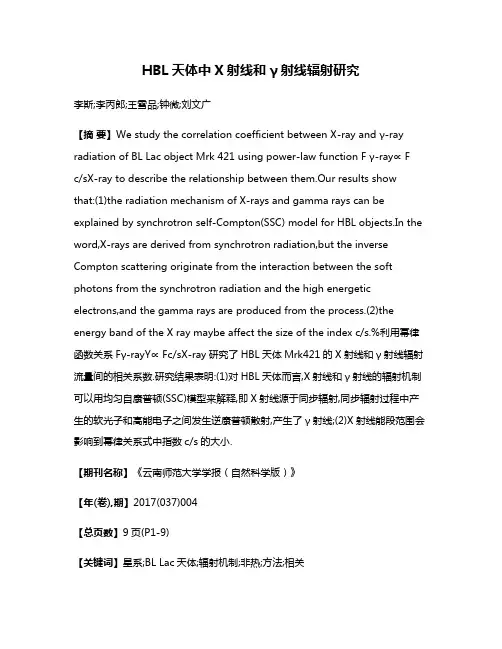
HBL天体中X射线和γ射线辐射研究李斯;李丙郎;王雪品;钟微;刘文广【摘要】We study the correlation coefficient between X-ray and γ-ray radiation of BL Lac object Mrk 421 using power-law function F γ-ray∝ F c/sX-ray to describe the relationship between them.Our results show that:(1)the radiation mechanism of X-rays and gamma rays can be explained by synchrotron self-Compton(SSC) model for HBL objects.In the word,X-rays are derived from synchrotron radiation,but the inverse Compton scattering originate from the interaction between the soft photons from the synchrotron radiation and the high energetic electrons,and the gamma rays are produced from the process.(2)the energy band of the X ray maybe affect the size of the index c/s.%利用幂律函数关系Fγ-rayY∝ Fc/sX-ray研究了HBL天体Mrk421的X射线和γ射线辐射流量间的相关系数.研究结果表明:(1)对HBL天体而言,X射线和γ射线的辐射机制可以用均匀自康普顿(SSC)模型来解释,即X射线源于同步辐射,同步辐射过程中产生的软光子和高能电子之间发生逆康普顿散射,产生了γ射线;(2)X射线能段范围会影响到幂律关系式中指数c/s的大小.【期刊名称】《云南师范大学学报(自然科学版)》【年(卷),期】2017(037)004【总页数】9页(P1-9)【关键词】星系;BL Lac天体;辐射机制;非热;方法;相关【作者】李斯;李丙郎;王雪品;钟微;刘文广【作者单位】云南师范大学物理与电子信息学院,云南省高校高能天体物理重点实验室,云南昆明650500;云南师范大学物理与电子信息学院,云南省高校高能天体物理重点实验室,云南昆明650500;云南师范大学物理与电子信息学院,云南省高校高能天体物理重点实验室,云南昆明650500;云南师范大学物理与电子信息学院,云南省高校高能天体物理重点实验室,云南昆明650500;云南师范大学物理与电子信息学院,云南省高校高能天体物理重点实验室,云南昆明650500【正文语种】中文【中图分类】P157.6BL Lac天体多波段能谱分布具有明显的双峰结构,低能峰位于光学波段到软X射线波段,而高能峰位于GeV到TeV区域[1].均匀同步自康普顿(SSC)模型能够较好地解释BL Lac天体的多波段能谱分布,在该模型中,低能峰由喷流内极端相对论性电子的同步辐射产生,而高能峰则由来自同一相对论性电子与同步辐射产生的软光子之间的逆康普顿散射(IC)产生,因此SSC模型认为产生X射线的电子与产生γ射线的电子是同源的.BL Lac天体根据低能峰(同步峰)的位置不同而分为低能峰BL Lac天体(Low-energy Peak BL Lacs,LBL)和高能峰BL Lac天体(High-energy Peak BL Lacs,HBL),LBL的同步峰主要位于光学波段,而HBL的同步峰主要位于紫外到X射线波段,因而研究HBL天体X射线波段和γ射线波段之间的相关性对于研究该类天体的辐射机制和物理过程有重要的意义.X射线和γ射线能段的观测[2-4]为两者流量同时性变化之间的相关性提供了直接的证据.1998年Mrk 421耀发活动的观测证明了X射线和γ射线之间存在紧密的相关性[5],证明了高能辐射的光子源于X射线耀发活动中产生的同步辐射软光子.Katarzyński等人[6]详细讨论了HBL天体Mrk 501的X射线辐射变化和TeV γ射线辐射变化之间的相关性,并且给出了一个简单的幂律函数来描述两者之间存在的关系.本文将采用他们对Mrk 501天体的研究思路,对Mrk 421天体X射线辐射变化和γ射线辐射变化之间的相关性进行详细的分析和讨论.均匀同步自康普顿(SSC)模型[6]常被作为HBL天体中X射线辐射和γ射线辐射的一种可能解释.Dermer等人[7-11]的研究工作表明SSC模型对全波段能谱分布(SED)中的X射线和γ射线的辐射机制能够给出较合理且简单的阐释.我们的目的是确定SSC模型是否可以解释光变观测到的具体特征.2.1 均匀同步自康普顿(SSC)模型均匀同步自康普顿(SSC)模型假设存在一个球形区域,且该区域无论处于膨胀状态还是压缩状态,它都是均匀分布的.为了简化物理模型、建立起描述该区域变化的数学表达式,只考虑该区域可能发生的四个基本物理过程:1)该球形区域体积的增加或减少;2)磁场强度的增强或减弱;3)粒子数密度的变化;4)粒子的加速或冷却.为了研究该区域内每个过程对辐射的影响,需要对每一个物理过程进行数学描述. 假设球形区域的半径为R,磁场强度为B.R和B随时间变化,这种变化可以用一个简单的幂律函数来表示:在(1)和(2)式中t0是初始时间, R0是初始区域半径, B0是初始磁场强度,指数re 和m都是自由参量.在初始时刻t0时,区域内电子能量分布可以用一个截断幂律函数来描述是电子洛伦兹因子(相当于电子的能量),描述的是截断的初始位置,n1是截断前的电子谱指数,n2是截断后的电子谱指数.在模型中我们假设X射线辐射和TeV γ射线辐射的主要成分均由电子能量为γbrk附近的电子产生.电子能谱的演化由下式的最小值决定其中的两个函数的具体表示如下:(5)和(6)式中,K1和K2指的是截断前后粒子数密度的变化,3rd是粒子数密度的增加或减少,粒子加速或冷却由指数ra(n1-1)或ra(n2-1)描述.如果假设的绝热膨胀或绝热压缩的区域内的粒子数密度是一个恒定的常数,那么参数re、ra和rd应该是相等的[12-13].为了分别研究上述过程的影响,需要给出详细的参数结果.电子的同步辐射系数由文献[14]确定,即(7)式中α=.因此,需要定义两个同步辐射系数,即表示低能电子辐射系数,即γ<γbrk;js2表示高能电子辐射系数,即γ>γbrk.忽略电子自吸收过程,因此可以估算出来自球形源的同步辐射强度,即可以求出同步辐射流量变化为(12)和(13)式中,s1是低能电子产生的同步辐射,s2是高能电子产生的同步辐射.以上两个流量之间的主要区别是辐射过程和磁场强度不同.2.2 逆康普顿散射IC自康普顿辐射又被称为逆康普顿散射(Inverse Compton scattering,简称IC). Tavecchio等人[15]用一个截断幂律谱详细研究了SSC辐射过程中的电子能谱.在他们的方法中,逆康普顿散射(IC)谱可以分为四个基本成分.而对于HBL天体,其中只有两个起主导作用的成分能产生自康普顿辐射,即:低能电子(K1,N1)和来自于同步辐射谱的第一部分(Is1,Fs1)共同作用而产生的F1,c,由高能电子(K2,N2)和来自于同步辐射谱的第一部分(Is1,Fs1)共同作用而产生的F2,c.因此,给出逆康普顿散射(IC)过程的主要辐射系数如下:通过类比同步辐射的推导过程,可以求出逆康普顿散射(IC)辐射强度为由此可估算出逆康普顿散射(IC)的流量值:其中c1描述的是在Thomson限制下的逆康普顿散射(IC)散射演化,c2描述的是在Klein-Nishina限制下的逆康普顿散射(IC)散射演化.为了研究HBL天体中X射线和γ射线之间的相关性,所选取的光变曲线必须满足以下条件[6]:1)X射线和γ射线的数据在同一时期内获得;2)两条光变曲线所选取的数据点的样本率相同,即在两条光变曲线上所选取的数据点的个数一致.在HBL天体中,时间变化的尺度非常短,可获得的数据点就比较多,因此光变曲线上的数据点也应该是比较密集的;3)额外的同时性能谱观测提供能谱演化的基本信息,例如,确定同步辐射产生的X射线Fs低于或者高于νFs(ν)峰.在实际的研究工作中,很难找到同时满足以上的所有条件的观测结果,仅在特殊情况下,X射线和γ射线的活动相关性可以被详细地研究和分析.图1展示了在2010年2月观测到的Mrk 421的光变活动.光变曲线分别是由Swift-XRT(0.5-2 keV)、RXTE-ASM(1.5-12 keV)、RXTE-PCA(2-20 keV)、Swift-BAT(15-50 keV)、Fermi-LAT(0.2-300 GeV)和HAGAR(>250 GeV)观测到的.其中X射线波段的光变曲线由Swift-XRT(0.5-2 keV)、RXTE-ASM(1.5-12 keV)、RXTE-PCA(2-20 keV)和Swift-BAT(15-50 keV)观测给出,γ射线波段的光变曲线由Fermi-LAT(0.2-300 GeV)和HAGAR(>250 GeV)观测给出.为了研究两者之间的相关性,需要对不同设备观测到的数据进行两两组合(如表1).观测数据在时间上是随机分布的,为了研究X射线波段和γ射线波段之间的相关性,需要对两个波段观测到的光变曲线进行比较,即选取在同一时段内两个波段同时性或者准同时性数据.但只按照这种方法进行,可能会出现如下情况:光变曲线上虽然有多个数据点,但是满足同时性或者准同时性的数据点相对较少.为了解决这一问题,可以在光变曲线中插入一个同时性的数据点,但注意这样做需要满足光变曲线有相似的采样,采样应该等于或者小于源的光变时间尺度特性变化.某些情况下光变曲线上的观测数据点之间存在着时间偏移,但由于这些数据点均为一天内的基本观测平均值,因此,采用插值法依然可以得到有效的结果.对(12)和(13)式进行对数处理,有对(17)、(18)式进行对数处理,得根据(19)、(20)、(21)、(22)式,得到关系式由(23)式可得在(24)式中,Fs(t)是同步辐射流量,其主要来源于SED图中同步辐射峰附近光子流量,即X射线流量,即FX-ray(t)≡Fs(t),Fc(t)是逆康普顿(IC)散射流量,其主要来源于SED图中IC峰附近光子流量,即γ射线流量,即有Fγ-ray(t)≡Fc(t).所以3.3 数据处理结果根据(23)、(24)、(25)式,对图1中Mrk 421天体光变曲线给出的X射线和γ射线辐射流量进行一元线性回归分析,分析结果如图2和表2所示.根据(23)式,在表2中自变量x表示logFs(t),因变量y表示logFc(t),线性关系的表达式为y=kx+b,其中k=c/s,b-er 是截距的误差范围的绝对值,k-er是斜率的误差范围的绝对值,N是数据点的个数,r为线性相关系数,p为置信度,SD为回归方程的标准偏差.由于k=c/s,根据(24)、(25)式,又可以得到如表3所示的结果.通过分析表2和表3中数据,可以得到以下结果:(1)图2(a)统计的logFXRT和logFLAT间呈现出显著的相关性,其相关系数为r=0.881 13,置信度P=0.020 35;图2(b)统计的logFASM和logFLAT之间也存在着显著的相关性,它的相关系数为r=0.767 62,置信度P=0.015 73;同样地,图2(c)、图2(d)分别统计的logFPCA和logFLAT、logFBAT和logFLAT的相关性也是特别显著的,其中图2(c)的相关系数为r=0.835 71,置信度P=0.019 19,图2(d)的相关系数为r=0.876 88,置信度P=0.004 25.(2)图2(e)、(f)、(g)、(h)中的统计结果分别表明logFXRT和logFHAG、logFASM和logFHAG、logFPCA和logFHAG、logFBAT和logFHAG之间呈现的相关性较弱,因为它们的相关系数r均小于0.5.(3) 当使用Swift-XRT(0.5-2 keV)和Fermi-LAT(0.2-300 GeV)观测时,得到的关系是用RXTE-ASM(1.5-12 keV) 和Fermi-LAT(0.2-300 GeV)观测时,得到的关系是用RXTE-PCA(2-20 keV) 和Fermi-LAT(0.2-300 GeV)观测时,得到的关系是用Swift-BAT(15-50 keV)和Fermi-LAT(0.2-300 GeV)观测时,得到的关系是用Swift-XRT(0.5-2 keV)、RXTE-ASM(1.5-12 keV)、RXTE-PCA(2-20 keV)、Swift-BAT(15-50 keV)探测到的X射线波段的辐射流量与用Fermi-LAT(0.2-300 GeV)观测到的γ射线波段的辐射流量之间存在着显著的相关性.这表明, HBL天体X射线和γ射线的辐射可以用均匀同步自康普顿(SSC)过程来描述,即X射线光子源于同步辐射,GeVγ光子产生于同源电子的逆康普顿散射.用Swift-XRT(0.5-2 keV)、RXTE-ASM(1.5-12 keV)、RXTE-PCA(2-20 keV)、Swift-BAT(15-50 keV)探测到的X射线波段的辐射流量与用HAGAR(E>250 GeV)观测到的γ射线波段的辐射流量之间没有相关性.对此做出如下解释:一般认为HAGAR探测到的γ射线的能量范围E>250 GeV,在这个能量范围以上产生的γ射线为次级γ射线,关于次级γ射线的产生,一种可能的解释是耀变体加速产生的高能宇宙线质子与河外背景光(EBL)光子、宇宙微波背景光(CMB)光子相互作用(pγ相互作用)产生了次级γ射线[17-19],或者高能光子之间作用产生的正负电子对可能通过逆康普顿散射过程散射微波背景光子,从而产生次级γ射线.如果采用简单的幂律公式来表示X射线和γ射线之间的关系,结合表3中的数据,X射线和γ射线的关系谱指数c/s≤1.Katarzyński等人[6]根据RXTE-PCA观测到的X射线辐射的光变曲线和用HEGRA观测到的TeV γ射线辐射的光变曲线,研究了两者的辐射流量之间的相关性,得到的结果是这个结果与我们的一致.但是我们研究的RXTE-PCA和Fermi-LAT 分别探测到的两条光变曲线的变化比Katarzyński等人用RXTE-PCA和HEGRA观测到的光变曲线的变化更好.根据表3给出的结果,发现X射线能段范围会影响到谱指数c/s的大小,即X射线能段范围不同,谱指数c/s也会不同.这个结论与Katarzyński等人[6]在研究Mrk 501天体时给出的结论是类似的,即相关性斜率可能依赖于谱带宽度.【相关文献】[1] URRY C M.BL Lac Objects and Blazars:Past,Present,and Future[J].ASP Conference series,1999,159:3-19.[2] BUCKLEY J H,AKERLOF C W,BILLER S,et al.Gamma-ray variability of the BL Lacertae object Markarian 421[J].The Astrophysical Journal Letters,1996,472(1):L9.[3] CATANESE M,BRADBURY S M,BRESLIN A C,et al.Multiwavelength observations of a flare from Markarian 501[J].The Astrophysical Journal Letters,1997,487(2):L143.[4] 李斯, 王艳芳, 龙光波,等. 费米耀变体多波段辐射流量相关性研究[J].云南师范大学学报:自然科学版,2015,35(6):1-7.[5] MARASCHI L,FOSSATI G,TAVECCHIO F,et al.Simultaneous X-Ray and TEV observations of a rapid flare from Markarian 421[J].The Astrophysical Journal Letters,1999,526(2):L81.[6] KATARZY SKI K, GHISELLINI G, TAVECCHIO F, et al. Correlation between the TeV and X-ray emission in high-energy peaked BL Lac objects[J].Astronomy &Astrophysics,2005,433(2):479-496.[7] DERMER,CHARLES D,SCHLICKEISER,et al.Model for the High-Energy Emission from Blazars[J]. Astrophysical Journal,1993,416(2):458-484.[8] BEDNAREK W,PROTHEROE R J.Testing the homogeneous synchrotron self Compton model for gamma ray production in Mrk 421[J].Monthly Notices of the Royal Astronomical Society,1997,292(3):646-650.[9] MASTICHIADIS A,KIRK J G.Variability in the synchrotron self-Compton model of blazar emission[J].Astronomy & Astrophysics,1997,320(1):19-25.[10]PIAN E,VACANTI G,TAGLIAFERRI G,et al.BeppoSAX Observations of Unprecedented Synchrotron Activity in the BL Lac Object Mkn 501[J].AstrophysicalJournal,1998,492(1):L17-L20.[11]KATARZY SKI K,SOL H,KUS A.The multifrequency emission of Mrk 501-From radio to TeV gamma-rays[J].Astronomy & Astrophysics,2001,367(3):809-825.[12]KARDASHEV N S.Nonstationarity of Spectra of Young Sources of Nonthermal Radio Emission[J].Soviet Astronomy,1962,6(12):317-327.[13]LONGAIR M S.Book-Review-High Energy Astrophysics-V.1-Particles Photons and TheirDetection-ED.2[J].Science,1992,257(5071):822-823.[14]RYBICKI G B,LIGHTMAN A P.Radiative processes in astrophysics[J].Weinheim:Wiley-VcH Verlag GmbH&Co.KGaA,2007.[15]TAVECCHIO F,MARASCHI L,GHISELLINI G.Constraints on the Physical Parameters of TeV Blazars[J].Astrophysical Journal,1998,509(2):608-619.[16]SHUKLA A,CHITNIS V R,VISHWANATH P R,et al.Multiwavelength study of the TeV blazar Mrk 421 during a giant flare[J].Astronomy & Astrophysics,2012,541(3):1053-1060.[17]ESSEY W,&KUSENKO A. A new interpretation of the gamma-ray observations of distant active galactic nuclei[J].Astropart. Phys.,2010,33(1):81-85.[18]ESSEY W,KALASHEV O E,KUSENKO A,et al.Secondary Photons and Neutrinos from Cosmic Rays Produced by Distant Blazars[J].Phys. Rev. Lett.,2010,104(14):141102.[19]ZHENG Y G,&KANG T.Evidence for secondary emission as the origin of hard spectra in TeV blazars[J].ApJ,2013,764(2):113-118.。
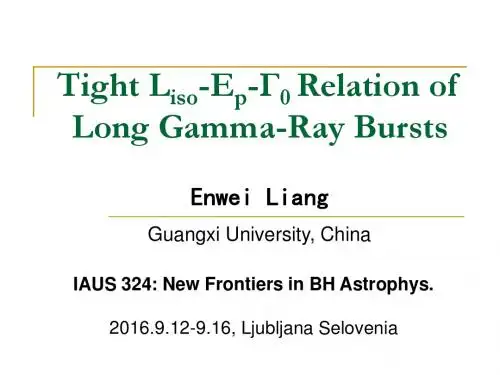
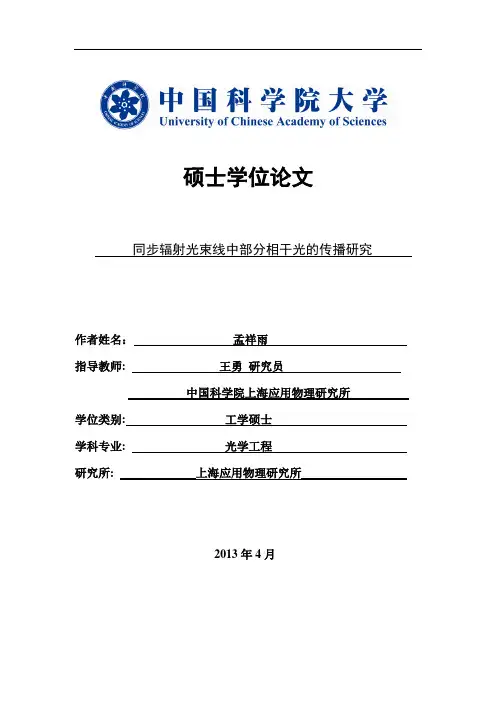
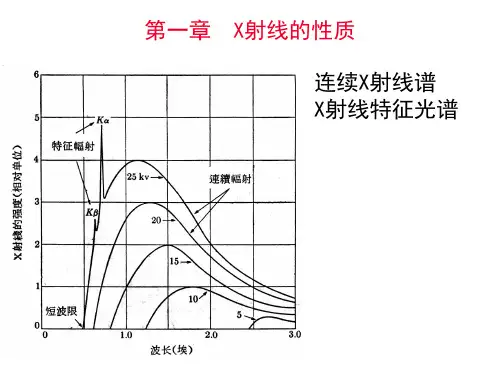
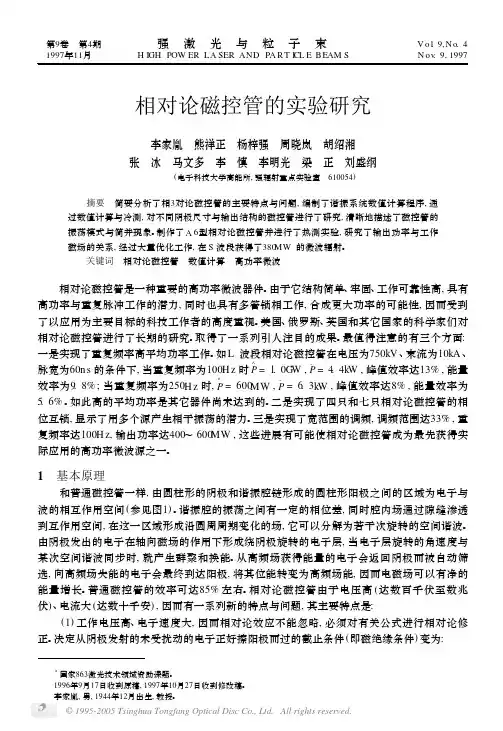
3国家863激光技术领域资助课题。
1996年9月17日收到原稿,1997年10月27日收到修改稿。
李家胤,男,1944年12月出生,教授。
相对论磁控管的实验研究李家胤 熊祥正 杨梓强 周晓岚 胡绍湘张 冰 马文多 李 慎 李明光 梁 正 刘盛纲 (电子科技大学高能所,强辐射重点实验室 610054) 摘要 简要分析了相3对论磁控管的主要特点与问题,编制了谐振系统数值计算程序,通过数值计算与冷测,对不同阴极尺寸与输出结构的磁控管进行了研究,清晰地描述了磁控管的振荡模式与简并现象。
制作了A 6型相对论磁控管并进行了热测实验,研究了输出功率与工作磁场的关系,经过大量优化工作,在S 波段获得了380MW 的微波辐射。
关键词 相对论磁控管 数值计算 高功率微波 相对论磁控管是一种重要的高功率微波器件。
由于它结构简单、牢固、工作可靠性高,具有高功率与重复脉冲工作的潜力,同时也具有多管锁相工作,合成更大功率的可能性,因而受到了以应用为主要目标的科技工作者的高度重视。
美国、俄罗斯、英国和其它国家的科学家们对相对论磁控管进行了长期的研究。
取得了一系列引人注目的成果。
最值得注意的有三个方面:一是实现了重复频率高平均功率工作。
如L 波段相对论磁控管在电压为750kV 、束流为10kA 、脉宽为60n s 的条件下,当重复频率为100H z 时P ^=1.0G W ,P -=4.4k W ,峰值效率达13%,能量效率为9.8%;当重复频率为250H z 时,P ^=600MW ,P -=6.3k W ,峰值效率达8%,能量效率为5.6%。
如此高的平均功率是其它器件尚未达到的。
二是实现了四只和七只相对论磁控管的相位互锁,显示了用多个源产生相干振荡的潜力。
三是实现了宽范围的调频,调频范围达33%,重复频率达100H z ,输出功率达400~600MW ,这些进展有可能使相对论磁控管成为最先获得实际应用的高功率微波源之一。

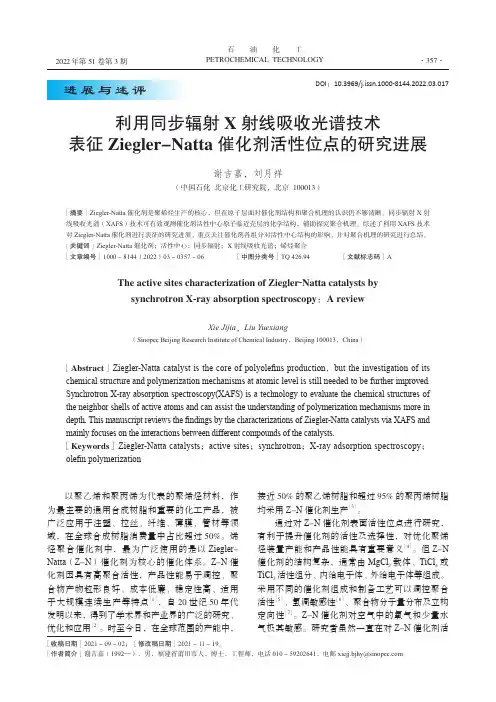
2022 年第51 卷第 3 期石油化工PETROCHEMICAL TECHNOLOGY·357·利用同步辐射X 射线吸收光谱技术表征Ziegler-Natta 催化剂活性位点的研究进展谢吉嘉,刘月祥(中国石化 北京化工研究院,北京 100013)[摘要]Ziegler-Natta 催化剂是聚烯烃生产的核心,但在原子层面对催化剂结构和聚合机理的认识仍不够清晰。
同步辐射X 射线吸收光谱(XAFS )技术可有效观测催化剂活性中心原子临近壳层的化学结构,辅助探究聚合机理。
综述了利用XAFS 技术对Ziegler-Natta 催化剂进行表征的研究进展,重点关注催化剂各组分对活性中心结构的影响,并对聚合机理的研究进行总结。
[关键词]Ziegler-Natta 催化剂;活性中心;同步辐射;X 射线吸收光谱;烯烃聚合[文章编号]1000-8144(2022)03-0357-06 [中图分类号]TQ 426.94 [文献标志码]AThe active sites characterization of Ziegler -Natta catalysts by synchrotron X -ray absorption spectroscopy :A reviewXie Jijia ,Liu Yuexiang(Sinopec Beijing Research Institute of Chemical Industry ,Beijing 100013,China )[Abstract ]Ziegler-Natta catalyst is the core of polyolefins production ,but the investigation of its chemical structure and polymerization mechanisms at atomic level is still needed to be further improved. Synchrotron X-ray absorption spectroscopy(XAFS) is a technology to evaluate the chemical structures of the neighbor shells of active atoms and can assist the understanding of polymerization mechanisms more in depth. This manuscript reviews the findings by the characterizations of Ziegler-Natta catalysts via XAFS and mainly focuses on the interactions between different compounds of the catalysts.[Keywords ]Ziegler-Natta catalysts ;active sites ;synchrotron ;X-ray adsorption spectroscopy ;olefin polymerization进展与述评DOI :10.3969/j.issn.1000-8144.2022.03.017[收稿日期]2021-09-02;[修改稿日期]2021-11-19。
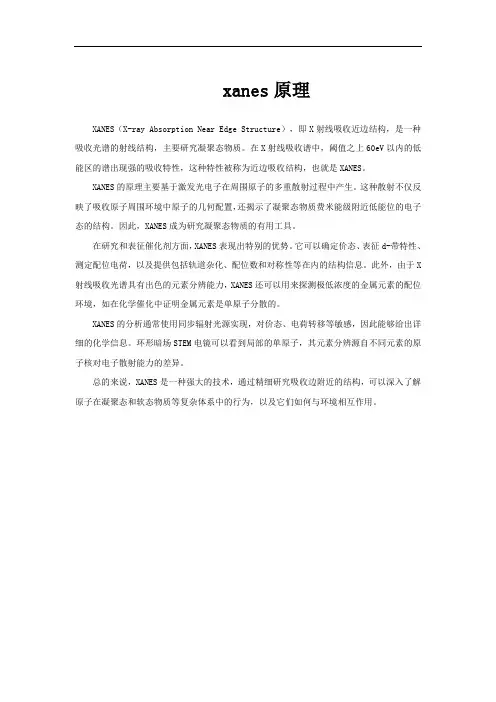
xanes原理
XANES(X-ray Absorption Near Edge Structure),即X射线吸收近边结构,是一种吸收光谱的射线结构,主要研究凝聚态物质。
在X射线吸收谱中,阈值之上60eV以内的低能区的谱出现强的吸收特性,这种特性被称为近边吸收结构,也就是XANES。
XANES的原理主要基于激发光电子在周围原子的多重散射过程中产生。
这种散射不仅反映了吸收原子周围环境中原子的几何配置,还揭示了凝聚态物质费米能级附近低能位的电子态的结构。
因此,XANES成为研究凝聚态物质的有用工具。
在研究和表征催化剂方面,XANES表现出特别的优势。
它可以确定价态、表征d-带特性、测定配位电荷,以及提供包括轨道杂化、配位数和对称性等在内的结构信息。
此外,由于X 射线吸收光谱具有出色的元素分辨能力,XANES还可以用来探测极低浓度的金属元素的配位环境,如在化学催化中证明金属元素是单原子分散的。
XANES的分析通常使用同步辐射光源实现,对价态、电荷转移等敏感,因此能够给出详细的化学信息。
环形暗场STEM电镜可以看到局部的单原子,其元素分辨源自不同元素的原子核对电子散射能力的差异。
总的来说,XANES是一种强大的技术,通过精细研究吸收边附近的结构,可以深入了解原子在凝聚态和软态物质等复杂体系中的行为,以及它们如何与环境相互作用。
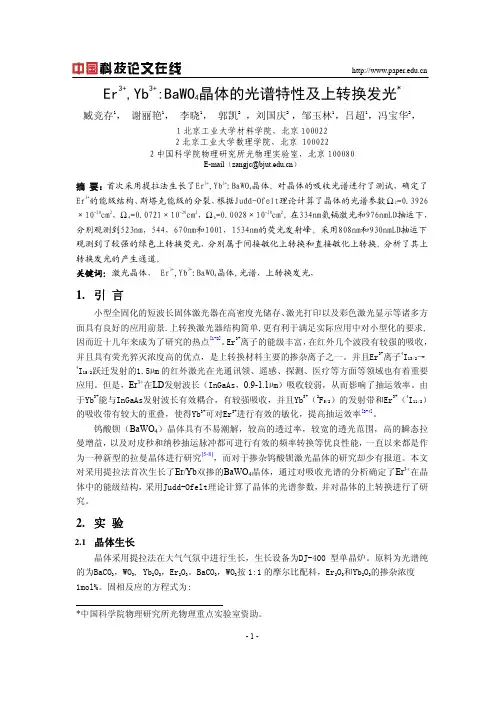
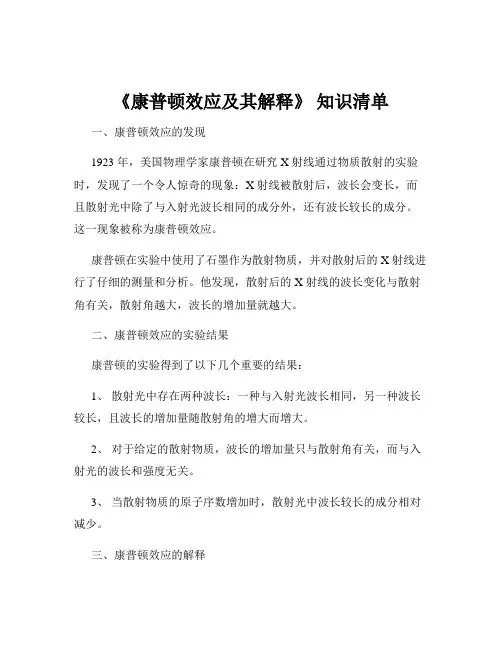
《康普顿效应及其解释》知识清单一、康普顿效应的发现1923 年,美国物理学家康普顿在研究 X 射线通过物质散射的实验时,发现了一个令人惊奇的现象:X 射线被散射后,波长会变长,而且散射光中除了与入射光波长相同的成分外,还有波长较长的成分。
这一现象被称为康普顿效应。
康普顿在实验中使用了石墨作为散射物质,并对散射后的 X 射线进行了仔细的测量和分析。
他发现,散射后的 X 射线的波长变化与散射角有关,散射角越大,波长的增加量就越大。
二、康普顿效应的实验结果康普顿的实验得到了以下几个重要的结果:1、散射光中存在两种波长:一种与入射光波长相同,另一种波长较长,且波长的增加量随散射角的增大而增大。
2、对于给定的散射物质,波长的增加量只与散射角有关,而与入射光的波长和强度无关。
3、当散射物质的原子序数增加时,散射光中波长较长的成分相对减少。
三、康普顿效应的解释为了解释康普顿效应,康普顿引入了光子与电子的碰撞模型。
根据这个模型,X 射线可以看作是一束光子流。
当光子与物质中的电子发生碰撞时,遵循能量守恒和动量守恒定律。
在碰撞过程中,光子把一部分能量和动量传递给了电子,导致光子的能量减小,从而波长变长。
具体来说,假设入射光子的能量为$E = h\nu$,动量为$p =h\nu / c$,其中$h$ 是普朗克常数,$\nu$ 是频率,$c$ 是光速。
与电子碰撞后,光子的能量变为$E' = h\nu'$,动量变为$p' =h\nu' / c$,电子获得了能量和动量。
根据能量守恒定律:$h\nu = h\nu' + E_e$,其中$E_e$ 是电子获得的能量。
根据动量守恒定律:$p = p' + p_e$,其中$p_e$ 是电子获得的动量。
通过联立这些方程,可以得到波长的变化量与散射角的关系,从而成功地解释了康普顿效应的实验结果。
四、康普顿效应的意义康普顿效应的发现具有重要的意义:1、证实了光子的粒子性:康普顿效应表明,光子不仅具有波动性,还具有粒子性,这是光的波粒二象性的重要证据之一。
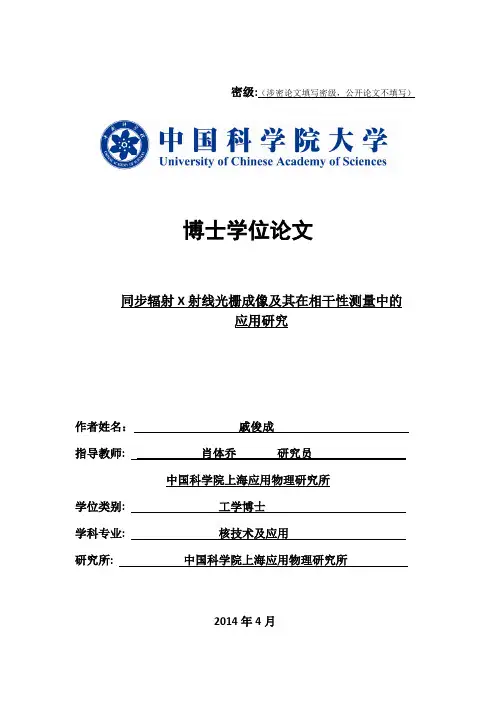
《康普顿效应及其解释》知识清单一、康普顿效应的发现在 20 世纪初,物理学家们对于光的本质的认识存在着波动说和粒子说的争论。
1923 年,美国物理学家康普顿在研究 X 射线通过物质散射的实验中,发现了一个令人惊讶的现象:X 射线被散射后,其波长会发生改变,而且散射后的 X 射线中出现了波长变长的部分。
康普顿使用了石墨作为散射物质,并测量了散射前后 X 射线的波长和强度。
实验结果表明,散射后的 X 射线不仅在原波长处有强度,还在较长的波长处出现了新的强度峰值。
二、康普顿效应的实验现象当一束 X 射线照射到石墨等物质上时,会发生散射。
散射后的 X 射线的波长不再与入射 X 射线的波长相同,而是出现了变长的情况。
并且,散射角越大,波长的变化也越大。
同时,康普顿还发现,散射后的 X 射线的强度分布与散射角有关。
在特定的散射角下,波长变长的 X 射线的强度达到最大值。
三、康普顿效应的解释为了解释康普顿效应,需要引入光子的概念。
根据量子理论,光具有粒子性,光子具有能量和动量。
当 X 射线光子与石墨中的电子发生碰撞时,光子和电子之间发生了能量和动量的交换。
电子被视为一个静止的自由电子,在碰撞过程中,光子把一部分能量传递给了电子,导致光子的能量减少。
由于光子的能量与波长成反比,能量减少意味着波长变长。
而且,散射角越大,光子与电子之间的碰撞越剧烈,能量损失也就越大,波长的变化也就越明显。
四、康普顿效应的数学推导假设入射 X 射线光子的波长为λ₀,频率为ν₀,能量为 E₀=hν₀,动量为 p₀=h/λ₀。
碰撞后,散射 X 射线光子的波长为λ,频率为ν,能量为 E =hν,动量为 p =h/λ。
电子在碰撞前静止,质量为 m₀,碰撞后获得了速度 v。
根据能量守恒和动量守恒定律,可以得到以下关系式:hν₀+ m₀c²=hν + mc²(能量守恒)h/λ₀=h/λ + mv (动量守恒)通过联立求解这些方程,可以得到散射后的波长λ与入射波长λ₀、散射角θ之间的关系:λ λ₀=(h / m₀c) (1 cosθ)这就是康普顿散射公式,它很好地解释了实验中观察到的波长变化与散射角的关系。
arXiv:astro-ph/9802078v1 6 Feb 19981HighenergypropertiesofX–raysourcesobservedwithBeppoSAXF.Fronteraa,b,D.DalFiumeb,G.Malagutib,L.Nicastrob,M.Orlandinib,E.Palazzib,E.Pianb,F.Favatac,A.Santangelod,
aDipartimentodiFisica,Universit`adiFerrara,ViaParadiso12,44100Ferrara,Italy
bIstitutoTecnologieeStudioRadiazioniExtraterrestri(TeSRE),C.N.R.,
viaGobetti101,40129Bologna,Italy
cAstrophysicsDivision,SpaceScienceDepartmentofESA,ESTEC
Keplerlaan1,2200AGNoordwijk,TheNetherlands
dIstitutoFisicaCosmicaeApplicazioniall’Informatica(IFCAI),C.N.R.,
viaLaMalfa153,90146Palermo,Italy
Wereportonhighlightresultsoncelestialsourcesobservedinthehighenergyband(>20keV)withBeppoSAX.Inparticularwereviewthespectralpropertiesofsourcesthatbelongtodifferentclassesofobjects,i.e.,stellarcoronae(Algol),supernovaremnants(CasA),lowmassX–raybinaries(CygnusX–2andtheX–raybursterGS1826–238),blackholecandidates(CygnusX–1)andActiveGalacticNuclei(Mkn3).Wedetect,forthefirsttime,thebroad-bandspectrumofastellarcoronaupto100keV;forCasAwereportupperlimitstothe44Tilineintensitiesthatarelowerthanthoseavailabletodate;forCygX–2wereporttheevidenceofahighenergycomponent;wereportacleardetectionofabroadFeKlinefeaturefromCygX–1insoftstateandduringitstransitiontohardstate;Mkn3isoneofseveralSeyfert2galaxiesdetectedwithBeppoSAXathighenergies,forwhichComptonscatteringprocessisimportant.
1.INTRODUCTIONHighenergypropertiesofcelestialX–raysourcesgiveimportantinformationtounderstandtheirradiationmechanismsandtheenergeticpro-cessesoccurringinthemand/orintheirenviron-ments.HardX–rayemission(>20keV)iscurrentlyobservedfromseveralclassesofX–raysources.GalacticX–raysourcesthatareknownemittersofhardX–raysincludeblack-holecandidates,X–raypulsars,weak-magnetic-fieldneutronstarsinLowMassX–rayBinaries(LMXRBs),mainlyX–raybursters(XRBs),CataclismicVariables(CV),inparticularPolars,Crab-likesupernovaremnants.Highenergyspectraofblack-holecandidates(BHC)havepermittedtoinferthepresenceofComptonizationprocessesofsoftphotonsoccur-ringclosetotheblack-hole(e.g.,inadiskcorona).XRBs,thatareweaklymagnetizedneutronstars(withsurfacefieldintensityB≤1010–1011G),turnedouttobehardX–rayemitters,oncethesensitivityofthehighenergyinstru-mentswasincreasedatthe10mCrablevel(see[1]forarecentreview).Fromtheirspectralproper-ties,similaritieswithanddiversitiesfromBHCshavebeeninferred,likethepresenceofanaccre-tiondiskthatcanextend,asinthecaseofBHC,closetothesurfaceofthecompactobject,andthepresenceofanadditionalcomponentofsoftphotonsthat,unlikeinBHCs,originatesfromtheneutronstarsurfaceandcanbeamajorsourceofthermalemissionandelectroncoolingthroughComptonization.X–raypulsarsarewellknownemittersofhardX–rays.ObservationsinthehardX–raybandarerelevantinordertogetameasurementofthemagneticfieldintensityattheneutronstarsur-face.EvenifcurrentmodelsoftheX–rayspec-trumoftheseobjectsarestillunsatisfactoryathighenergies,themeasurementofcyclotronreso-nancefeaturesgivesadirectestimateoftheinten-2Figure1.UnifiedmodelforAGNs.Adaptedfrom[4].
sityoftheneutronstarmagneticfieldstrength[2].Emissionfromyoungshell-likesupernovarem-nantsmainlyextendstolowenergies(<20keV).DetectionofhardX–rayswithdeterminationoftheirspectralpropertiescanprovideimportantinformationontheemissionmechanism(thermalvs.nonthermal,likesynchrotronradiation).Fromstellarcoronae,aparttheSun,hardX–rayshaveneverbeenobserved.Aswewillsee,thisgaphasbeenfilledwithBeppoSAX.AmongtheextragalacticX–raysources,hardX–rayemissionisobservedfromActiveGalacticNuclei(AGNs),thatincludeSeyfertgalaxiesofbothtypes(1and2),radioquietQSOsandra-dioloudQSOs(whichincludeblazars).Agreateffortiscurrentlyunderwaytointerpretthedif-ferentclassesofAGNsinaunifiedscheme,whichissketchedinFig.1.Thebasicenergyproductionmechanismisaccretionofmatterontoamassiveblackhole(≈108M⊙)viaanaccretiondisk.A
massivetoroidoflargerradius(intherangefromseveralparsecstofewtensofparsecs[3])isas-sumedtosurroundtheaccretiondisk.Dependingontheconfigurationofthediskwithrespecttothetoroid,ontheirrelativesizesanddistances,andontheviewingangle,anAGNshouldshowdifferentobservationalfeaturesandthusfallinoneofthedifferentclassesabovementioned.Theaboveschemeisbeingtestedalsoforstellar-massblackholes(e.g.,CygnusX–1).Thustheunifiedschemecanbeageneralpicturetoin-terpretgalacticandextragalacticblackholes,ac-cretingmatterviaanaccretiondisk.GivenmanysimilaritiesintheX–rayemissionfromstellarmassBHswithlow-magnetic-fieldneutronstarsinLMXRBs,theunifiedschemenowappliedtoAGNscouldbeextendedtoseveralclassesofX–raysources.HardX–rayspectralpropertiesofthesesourcescanprovideuniqueinformationtodiagnosethepresenceofablackholeversusaweak-magnetic-fieldneutronstar,totesttheuni-fiedmodelforAGNsanditsvalidityforstellarmassBHCs.Thanktoabroadenergybandofoperation(0.1–300keV)andauniformfluxsensitivityinthisrange,BeppoSAX[5]hastheunmatchedca-pabilityofsimultaneouslysamplingthespectrumofX–raysourcesovermorethanthreedecadesofenergy.TheSAX/PDSinstrument[6],withasensitiv-ityofabout1mCrabat100keV,allowsanaccu-ratedeterminationofthespectrumofmanyX–raysourcesatthehighestenergies(13–200keV).Forthebrightestsources(>10mCrab),theHPGSPCinstrument(6–60keV)[7]providesthespectralcoveragenecessarytomatchtheinfor-mationprovidedbythelowenergyinstrumentsLECS(0.1–10keV)[8]andMECS(2–10keV)[9]telescopesandthePDS.HerewereviewsomerelevantresultsobtainedwithBeppoSAXduringitsPerformanceVerifi-cationPhaseandfirstyearCoreProgram,withparticularfocusonthePDSinstrument.ThespectraldeconvolutionwasperformedwiththeXSPECsoftwarepackage,byusingtheinstru-mentresponsefunctiondistributedfromtheBep-poSAXScientificDataCenter.